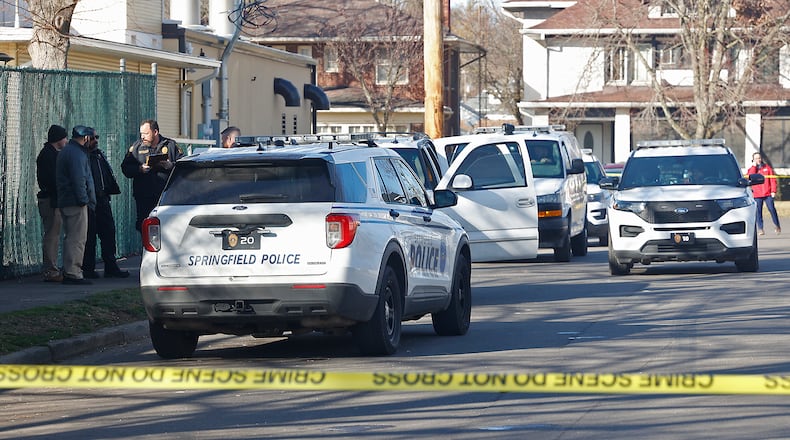On behalf of a citizen who had expressed concern about the issue, Springfield City Commissioner Tracey Tackett asked about the decision to utilize encryption at a recent city commission meeting.
City Manager Bryan Heck responded that the city had been reviewing the possibility for some time, examining the impact the practice can have on officer and public safety.
Springfield Police Division Chief Allison Elliott read a statement explaining reasons for the encryption of the main police radio channel.
“It didn’t just happen as a snap decision,” Chief Elliott explained. “Some things that happened over September prompted us to move forward more quickly with this process.”
Multiple city and county government buildings, schools, businesses and nonprofit organizations were targeted with threats in September when the city landed in the national immigration spotlight. President-elect Donald Trump and running mate J.D. Vance amplified false social media allegations about Haitian immigrants in Springfield stealing, killing and eating pets.
Credit: Bill Lackey
Credit: Bill Lackey
Those rumors have been thoroughly debunked, but over a two-week period, the city experienced a chaotic cascade of personal and public threats and demonstrations by extremist groups.
With the growth of apps and technology, thousands more people listen to police scanners than in the past.
According to New York Times reporting several months ago, Denver, San Francisco, San Diego County, Baltimore, Chicago, New York and Sioux Falls were among the jurisdictions that had recently encrypted radio signals to some degree. Minneapolis and Indianapolis were considering it. In Omaha, Nebraska, police provide the scanner feed to the public, but on a 15-minute delay.
The American Civil Liberties Union is among the groups that has pushed back against the policy. They say it means drivers not learning about accidents before they are stuck in traffic, journalists unable to get an independent camera to critical incident scenes, and unnecessary questions to emergency dispatchers when people could otherwise know about and share important information.
Elliott acknowledged that the concerns opposing the city’s move “are rooted in the community’s desire for transparency, accountability and real-time access to information about critical situations. I value these concerns because they reflect the trust and partnership we strive to maintain with all members of our community.”
But the chief said encryption was determined to be necessary. She cited “the safety of our officers and the safety, privacy and dignity of the people that we serve” as the two driving priorities for encrypting radio communications and limiting the ability of the public to access radio transmissions.
Elliott said that open radio channels have at time compromised safety in the community.
“Sensitive information such as officer location, tactical plans and even the personal details of victims or witnesses has been accessible to anyone listening. This creates vulnerabilities that could be exploited by some who would do harm, potentially jeopardizing the outcome of police operations.”
“Equally concerning is the impact on individuals experiencing emergencies,” she continued. “Imagine facing the worst day in your life, be it a medical crisis, a violent crime or another personal tragedy, only to have your name, address and the raw details of the situation broadcast in real time for anyone to hear on a worldwide platform. This kind of exposure can compound an already traumatic experience.”
Credit: Bill Lackey
Credit: Bill Lackey
Chief Elliott said encryption prevents such risks and allows officers to respond without compromising operational security or the privacy of individuals involved.
“We live in an age when information can spread across the globe in seconds,” she said. “The open nature of traditional radio channels often exposes personal information — names, addresses and details of crises — to anyone listening. This is a serious concern as identify theft and fraud are on the rise.”
Encryption, she said, is one way such sensitive information can be safeguarded so that it is not recklessly or maliciously shared.
She said encryption can also reduce problems related to the compromise of crime scenes and investigation integrity.
“Individuals have shown up at active scenes, sometimes interfering with investigations or removing evidence,” Elliott said. “This not only undermines the justice process, it can have a devastating impact on victims and their families.”
She challenged the belief that there is a direct link between radio transmissions and police transparency.
“Radio communications are often incomplete and can lead to misinformation,” she said. “When members of the community hear incomplete information, it can lead to speculation or assumptions that do not reflect the reality of the situation.”
She observed that the recent addition of body-worn cameras by officers “provide a more full, unfiltered and accurate record of interactions and incidents … This technology ensures that the public has access to a factual and comprehensive account of an officer’s actions while safeguarding information.”
Elliott called encryption another technological tool that enhances public safety and reported that the police continue to work on ways to better share information with the community.
“Transparency and accountability are at the core of everything we do,” Chief Elliott said. “We are actively developing systems to provide more timely updates on significant incidents in a way that respects safety, privacy and accuracy.”
About the Author


